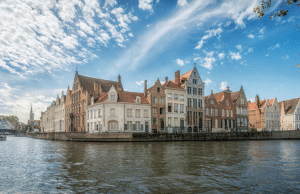Dušan Brejc has been in the wine business for three decades. After graduating at the Biotechnical Faculty and finishing his oenology specialisation in France he worked as an oenologist for ten years. Over the next decade he focused on marketing his produce and for the last ten years he has been managing the Wine Society of Slovenia. He is a wine writer (Nedelo-OK), lecturer and international taster.
What is Slovenia best known for on the international wine market? Which wine is immediately attributed to it? The answer to this question is never unanimous in established wine-growing countries. It would be too simplistic to say that France is known solely for Champagne, Bordeaux and Burgundy and forget about the Loire and Rhone valley and the entire south of France, where over a third of all its wine is produced. But it is still true that Bordeaux is a step ahead of the other regions, in the opinion of many connoisseurs. Countries we immediately connect to a certain wine brand on the international market usually export 30 or even over 50 percent of their wine produced. In this sense, Slovenian wines limit their chances of becoming visible, since exported volumes are still relatively small, representing no more than 7 percent of total wine produced. This raises the classic dilemma: what is more prudent – to export larger quantities of wine in the middle price range or smaller quantities of prestigious, expensive wines? As always the answer isn’t simple. Chile is known for low prices and a wide presence in a number of countries around the world. New Zealand doesn’t have a significantly larger wine-growing area than Slovenia, but is world famous for its sauvignon and the highest average price of exported wines. Nonetheless, in terms of quantity and value of export it can’t really compete with France or Chile. Within this dilemma we have refined the question we need to address professionally.
Let’s take a brief look at how it was, how it is and, since we’re daring, let’s try to figure out how it will be. Lately we have been pretty optimistic, despite serious consequences of the general financial and economic crises, which can be especially serious for a small and dependent economy like Slovenia’s. Yet the positive development of quality and style we have witnessed in the last few years are encouraging: if you work long enough and well enough the results are sure to follow.
How it all began
It would be wise to begin the story of Slovenian wines in the period following the Second World War. We were a part of Yugoslavia, yet at the same time our own republic. The seat of the once great Slovin wine producer, with 6000 employees across the country from north to south, was in Ljubljana. During the time of its peak exports, Slovin contributed almost 2 percent to the world wine trade. Until the mid eighties quantity oriented brands were important in the United Kingdom, Germany and the USA. These were the three most important export markets. Scandinavia, Benelux, Japan and Poland followed with a significantly smaller percentage. Slovenian wines represented a small part of the export and they were mostly white. The nineties and Slovenia’s independence completely changed our options. At the same time we lost our export markets. The large Slovin industry was struggling to grow before that, with the market having become globalised and moves in the quality game became sharper and quicker.
When true independence came in 1991 we inherited large quantity markets, yet lost the wine. On the Yugoslavian market almost a fifth of the wine came from Macedonia, which was always lower priced. The only logical reaction was to turn towards quality! In the first decade of independence the quality imperatives took over some smaller family businesses, with some making it big and succeeding internationally. Of note here is Aleša Kristančiča – Movia, who made it into some important international magazines due to his immense personal energy. Of course it would be inaccurate to say that the international profile of Slovenia increased due to the success of a few individuals – it has much more to do with the presence of wine on the market than with a limited number of top-notch winemakers and wines.
Systematic approach after 2000
If the nineties were marked by the progress of smaller winemakers, after 2000 larger Slovenian winemakers who systematically invested in technology started to catch up and sometimes overtake the smaller ones. Growth and, more importantly, adaptation to the trends on the international market is the best recipe for creating ‘Wine Destination Slovenia’ – the only assurance of long-term success in marketing wines on the foreign and domestic market. Partners of the Wine Society of Slovenia, which brings together the most important winemakers, set a strategy of 80:20 in 2006. This means that we aimed to export over 20 percent of our wine, which we managed to do. With the help of in-the-field oenologists style adjustments were carried out, there was participation at the biggest trade shows (Prowein, Germany; VinItaly, Italy; LIWTF, UK), we published in the most important B2B publications, carried out pre-planned PR activities and participated at international competitions, and encouraged important buyers to include wines of Slovenian partners in their sales programme.
We can certainly say today that our hard work paid off. And now we are faced with the equally difficult task of maintaining and increasing these numbers. It is interesting to note that the wines of our largest producers (Goriška Brda z.o.o., Vipava 1894 d.d., P&F wineries) first appeared in restaurants and not in stores, as one would expect. This suggests the ratio of quality to price of our wines first leads to more demanding consumers, which is evidence of the general high quality of Slovenian wines. The family Pukalvec and friends (P&F) made considerable investments in modern technology and brought some formerly famous wine-growing locations back to life. With large exports to China, UK and the Benelux region it now significantly impacts on the quality and profile of Slovenian wines.
What’s next?
In 2010 Slovenian wines were sold in 60 countries across almost every continent. Many people got to know our excellent wines, some for the first time. We realised it’s also about the diversity of the offer, not just the quality. Slovenian winemakers are in tune with nature and have a lot of imagination. In most Slovenian vineyards grapes are grown in a natural and eco-friendly manner. This fact should not be overlooked. What we are missing is a common way of thinking: each winemaker is in essence an individual. Winemaking demands the entire dedication of the winemaker, leaving little time for teamwork. This can be a major flaw. When Australia published their strategy to 2025 they asked themselves: after we share our strategy will the competition breathe down our neck even more? The answer was: of course not! The success of a wine-growing country depends mostly on teamwork and the Aussies are pretty good at that.
This year’s talks and deals between large and small winegrowers demonstrate that the idea of teamwork is gaining momentum. This is our greatest hope for raising the profile of all Slovenian wines on the international market.
Dušan Brejc













